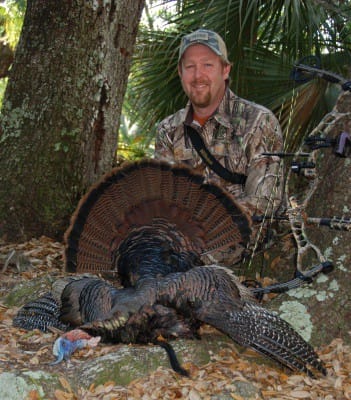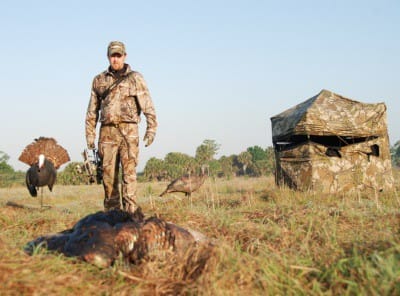Submitted By:
Tim Herald – USA Guest Author
 Many serious turkey hunters consider the Osceola, or Florida wild turkey, the crown jewel of the grand slam. True, this subspecies has by far the most limited range, public hunting opportunities are scattered, Osceolas are known for being less vocal than other birds, and outfitted trips are among the most sought after and often expensive of all turkey hunts. But if you will shift gears, slow down, and be conservative in your tactics, actually harvesting an old black-winged Osceola is certainly not as impossible as some might lead us to believe.
Many serious turkey hunters consider the Osceola, or Florida wild turkey, the crown jewel of the grand slam. True, this subspecies has by far the most limited range, public hunting opportunities are scattered, Osceolas are known for being less vocal than other birds, and outfitted trips are among the most sought after and often expensive of all turkey hunts. But if you will shift gears, slow down, and be conservative in your tactics, actually harvesting an old black-winged Osceola is certainly not as impossible as some might lead us to believe.
I have hunted Osceola turkeys for 20 years, and through that time, I have hunted with some of the best turkey chasers in the state of Florida. By spending quite a bit of time in the field with these fine gentlemen, I have also learned a good deal about their turkeys and how to consistently carry one to camp in the back of my vest. Mike Tussey and Ken Mayes are long-time Osceola outfitters and very close friends of mine. They have both taught me a lot over the years, and hopefully their knowledge can help you as well.

Tussey taught me that the number one key to consistently killing Florida turkeys is scouting.
“Our birds are about as patternable as a turkey can be. Of course they switch things up on you from time to time, but pre-hunt scouting is the biggest key to success down here,” the veteran guide said. “We put in a lot of time glassing birds in big cattle pastures in the morning and afternoon. You can watch birds from 400 to 500 yards away and be undetected, but you can gain valuable knowledge that will help you set up in the right place.”
Dozens of times Tussey and I have gone out to listen to birds on the roost, and after flydown, slipped around glassing to see where the gobblers prefer to strut first thing in the morning and what direction and time they leave that area during their daily routine. Mike taught me that you can do this in the afternoons as well. If you aren’t back in a swamp somewhere, Osceolas really like to be in open areas in and around cattle pastures throughout the day.
After Tussey gets a fix on one or more gobblers, he formulates a plan.
“We are bowhunting a lot more these days, so after we know a bird’s general roost and strut area, we have been utilizing Primos Double Bull blinds a lot. We slip in very early, get comfortable in the blind with decoys in front, and patiently wait. Of course we call and all the normal turkey hunting stuff, but the location is key,” he said.
Ken Mayes is a master at taking late-morning and afternoon birds with his clients, and I have shot a few nice toms with Ken over the years. I call him the “Magnet” because it seems wherever Ken sits down, an Osceola gobbler eventually shows up. Of course, that is because Ken knows where to sit because of his scouting.
“We have sandy soil down here in south Florida, so tracks and strut marks are easy to find. If I can find a lot of big gobbler tracks and obvious wing drag marks in the sand, I will wipe the area clean with my boot. Then I go back a day or two later, and if all the sign is there again, I know a gobbler uses the area regularly. I am patient, so I have no problem waiting a few hours until the turkey shows up,” Mayes said.

When I hunt in this style with Ken, we either hide behind some cabbage palm fronds or in a Double Bull blind, call lightly every 15 to 20 minutes, and just wait the birds out. Ken believes in calling softly unless a bird responds and gets fired up as the hunt progresses, and I have yet to go with Ken on one of these forays and not kill a bird.
I don’t want to say you can’t “run and gun” Osceolas and be successful, but you won’t be nearly as successful on a consistent basis as you will if you slow down and hunt smart. The habitat in Florida is either really open, or really thick, and in both instances, if you are running around all day cranking on a box call, you are going to spook way more birds than you will ever get a chance to honestly hunt.
I have also found that Osceolas are aggressive birds, and the use of a strutting decoy works really well in Florida, especially in open cattle pastures. I prefer Primos B-Mobile because the body size is smaller than most other strutting decoys, and since Osceolas are small, B-Mobile is not at all intimidating.
For three years in a row, I have taken an Osceola within 30 minutes of the season opening with a bow by using what I learned from Tussey and Mayes. Last spring was one of my all time favorite turkey hunts, and it was textbook Osceola hunting.
I always arrive on the property I hunt two days early and do a little scouting. The first morning I heard birds in a place I had never hunted, so I slipped up a ditch and glassed a big flock of more than two dozen birds. There were lots of hens, and six big gobblers. The longbeards were gobbling a lot for any subspecies, not to mention for Osceolas, so I enjoyed the show.
The next morning, the turkeys did the same thing, so I went back at noon, and I set a Double Bull Matrix 360 right in the middle of the field. Early on opening morning, I crept into the field, stuck up B-Mobile and a hen decoy and slid into the blind. The birds were roosted about 150 yards away, so I made sure to get there in total darkness and be as quiet as possible.
Right on cue the gobblers welcomed the dawn with a loud chorus, and soon after, birds began sailing out of their respective trees. The hens made their way toward me, but they all passed by at about 45 yards. The gobblers were hanging back a bit, but it seemed they would follow all the ladies well out of bow range.
I began calling softly on my AlumnaSlate, and though the toms would gobble, they didn’t seem too interested in straying from their course. I kept up the soft yelps and purrs, and eventually a hen broke off the group and walked straight up to my decoys. That’s all it took, and four of the big strutters broke and came in on a string. One bird was dominant, and he displayed for B-Mobile and gave him a wing smack.

I used that as an opportunity to draw my Hoyt AlphaMax, and when he gave me a clear shot at a long 4 yards, I sent a Carbon Express arrow right through the boiler room. He went all of three steps.
Scouting, setup and soft calling killed that gobbler that carried 1 9/16-inch spurs, and I couldn’t have done it if Mike Tussey and Ken Mayes hadn’t schooled me in the ways of slowing down for Osceolas.
To book a quality Osceola hunt, go to www.grandslamhunts.com







